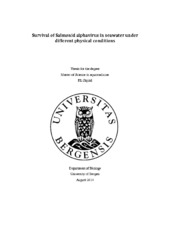Survival of Salmonid Alphavirus in seawater under different physical conditions
Master thesis
Permanent lenke
https://hdl.handle.net/1956/15822Utgivelsesdato
2014-08-06Metadata
Vis full innførselSamlinger
Sammendrag
Pancreas disease (PD) is an infectious disease caused by Salmonid alphavirus (SAV), which infects Atlantic salmon, Salmo salar L., and rainbow trout, Oncorhynchus mykiss (Walbaum). PD causes substantial economical losses in salmonid aquaculture in Europe, and has, since the early 2000s, steadily increased in extent in Norwegian aquaculture. Knowledge concerning transmission pathways for the causative agent is of paramount importance in order to combat the disease. Many authors have emphasized horizontal transmission as the most important pathway for infecting new cohorts and hydrodynamic models have been used to investigate if waterborne transmission by passive drift by ocean currents could explain why PD outbreaks has a tendency to cluster in time and space. SAV RNA has been detected in a lipid film, often seen in and around salmon farms, and this lipid film has therefore been proposed to contribute to dissemination of SAV between adjacent farms, driven by wind and currents. An important premise in such models is how long the virions remain infective in seawater outside its host. The survival of SAV in natural seawater and in seawater exposed to ultraviolet radiation (UVR) with wavelengths present in sunlight, simulating actual conditions in the natural environment, was investigated in this study. SAV infectivity was examined in parallel beakers containing natural seawater, sterile seawater and sterile seawater with an oil layer over a time period of 72 hours. Equivalent parallels were additionally exposed to UVR. The UV index-value used in the experiment was measured to be 22 at the surface of the water and a mean value 11 in the beakers was calculated. At 10 sampling points, water samples were taken from each beaker and infectivity was tested in CHSE-214 cells. Water samples were also analysed by real-time RT-PCR to detect viral RNA. In beakers containing sterile seawater, both with and without oil, infective virions were isolated throughout the experiment. In beakers containing natural seawater, the last infective virions were isolated at 48 and 24 hours after start, respectively. In beakers containing seawater and oil exposed to UVR, infective virions were isolated after 3 hours. In the other beakers exposed to UVR, infective virions were only isolated at the start of the experiment. Based on the results in this study, it is anticipated that SAV virions will survive for less than 72 hours in the natural environment, given a seawater temperature around 10°C.
